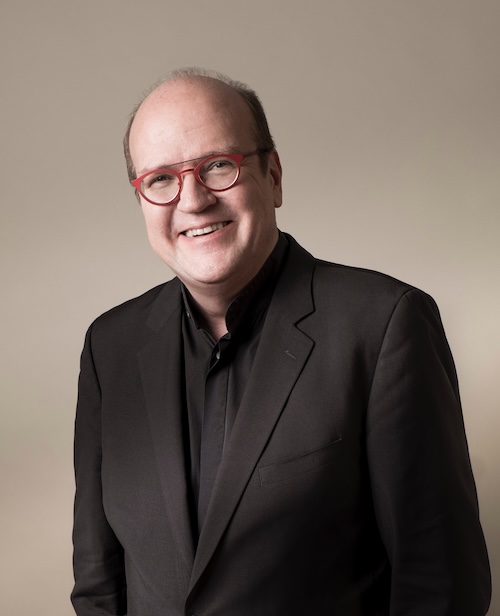Labadie leads an intimate, consolatory performance of Fauré Requiem

Bernard Labadie conducted the National Symphony Orchestra Thursday night in music of Fauré, Mozart and Rigel. Photo: Dario Acosta
Since stepping down as music director of Les Violons du Roy in 2014, Bernard Labadie has turned more and more to music after the 18th century. Currently principal conductor of the Orchestra of St. Luke’s, until the end of next season, the Quebec-born Labadie made his debut Thursday night at the podium of the National Symphony Orchestra, in a Paris-centered program heard in the Kennedy Center Concert Hall.
Labadie made his BSO debut in 2018 with a velvet-gloved all-Mozart program. The first half of this concert took up the same matter from a different angle, pairing two relatively brief three-movement symphonies, one by Henri-Joseph Rigel and the other by Mozart.
Rigel, despite his French-sounding name, was born in Germany. He moved to Paris in 1767, when he was still in his 20s, and wrote many works for Le Concert Spirituel, including his Fourth Symphony, published as one in a set of six in 1774. The orchestra was at its most modest size of the evening for this piece, with just under thirty string players, plus pairs of oboes, bassoons, and French horns.
Seated on a bench placed on a high rostrum, Labadie shaped the piece with elaborate gestures. The strings, following period practice, played mostly senza vibrato, with clean intonation and precise attacks. On the repeat of the exposition in the first movement, there was an early horn entrance at one point, a minor distraction.
The strings expanded on their glowing ensemble sound in the second movement, answered by Jamie Roberts’ pert oboe. A crisply articulated third movement romped at a lively tempo, with transparent balance among sections that revealed the inner workings of the score in unexpected ways.
Mozart was also thinking about moving to Paris around this time, as he searched for employment while visiting the city in 1778. The orchestra of Le Concert Spirituel gave the public premiere of his Symphony No. 31, now dubbed the “Paris” Symphony, commissioned by the series’ director, Joseph Legros. Mozart took advantage of the orchestra’s larger instrumentation, performed here with another dozen string players, and a full complement of woodwinds and brass, including clarinets for the first time in a Mozart symphony.
Trumpets, horn, and timpani were kept in scale in this elegant interpretation but added to the sense of forceful and incisive attack in the boisterous first movement. The violins brought out the rising scale of the initial motif, a figure sometimes called the “Mannheim rocket,” which figures prominently throughout the movement. Labadie chose to conduct Mozart’s original slow movement, a demurely paced Andantino, with pale shimmers of Aaron Goldman’s flute part peeking through the texture.
Labadie pushed the tempo of the third movement to extremes, which the violins handled with confidence but led to a few stumbles in the woodwind responses. As a sort of encore, Labadie announced that the NSO would also play the alternate slow movement, a more compact but possibly more charming Andante, that Mozart wrote for a later performance. The chance to compare the two options proved a delight.
In the second half came the hope-filled setting of the Requiem Mass by Gabriel Fauré, composed in phases beginning in 1888, also for performances in Paris. The Washington Chorus, trimmed down to about seventy singers, produced a refined choral sound, with clear diction of the Latin texts. Well prepared by artistic director Eugene Rogers, the tenor and soprano sections acquitted themselves admirably in their respective solo parts in the opening movement.
Labadie carefully reined in the orchestra, playing the 1900 version of the score (in the new critical edition by Christina Stahl and Michael Stegemann), to make an ideal balance with the singers. For the first two movements divisi violas and cellos warmly accompanied the voices. Bass-baritone Michael Sumuel handled his solo parts with chant-like simplicity and clarity, summoning up considerable power in the “Libera me.”
Soprano Joélle Harvey took the stage only for the Requiem’s centerpiece, a radiant interpretation of the “Pie Jesu” movement. She floated the exposed solo line beautifully, soaring into the heights, her pure tone always at the precise center of the pitch.
The harp made an angelic appearance in the “Sanctus” movement, with the violins repeatedly intoning the soprano line (“Te decet hymnus”) from the first movement like a soaring prayer. Horns, trumpets, and trombones backed up the loudest parts of this reserved score, in the “Agnus dei” and “Libera Me” movements, with the choir balanced and sounding at its fullest volume.
Fauré chose to end the piece, somewhat unusually, with a setting of “In Paradisum” from the burial service. Organist William Neal added subtle sounds to the orchestral fabric throughout the evening, coming into his own in this concluding movement. The soprano section sang this music with child-like wonder and a youthful sound, mostly shorn of vibrato to match the strings. Closing the piece in this quiet way, Fauré emphasized not the fear of hell and damnation, only the assurance of eternal rest.
The program will be repeated 8 p.m. Saturday. kennedy-center.org
